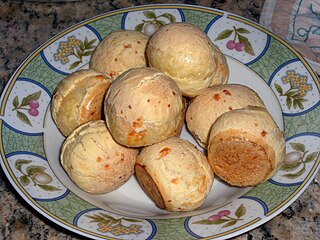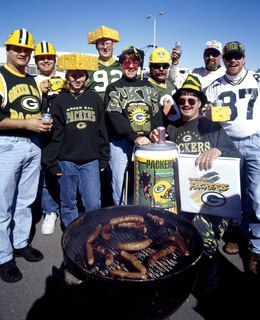
Argentine cuisine is described as a cultural blending of Mediterranean influences brought by the Spanish during the colonial period and, later, by Italian and Spanish immigrants to Argentina during 19th and 20th centuries, with influences from a further cultural blending of criollos with the Indigenous peoples of Argentina.
Pigs in a blanket is a variety of different sausage-based culinary dishes. Smaller versions of the dish are commonly served as an appetizer or hors d'oeuvre, sometimes with a mustard or aioli dipping sauce, or are accompanied by other foods during the main course.

An empanada is a type of baked or fried turnover consisting of pastry and filling, common in Spanish, other Southern European, Latin American, and the Philippines cultures. The name comes from the Galician verb empanar, and translates as "enbreaded", that is, wrapped or coated in bread. They are made by folding dough over a filling, which may consist of meat, cheese, tomato, corn, or other ingredients, and then cooking the resulting turnover, either by baking or frying.

Pão de queijo or Brazilian cheese bread is a small, baked cheese roll or cheese bun, a popular snack and breakfast food in Brazil. It is a traditional Brazilian recipe, originating in the state of Minas Gerais.

Colombian cuisine is a compound of the culinary traditions of the six main regions within the country. Colombian cuisine varies regionally and is particularly influenced by Indigenous Colombian, Spanish, and African cuisines, with slight Arab influence in some regions. Furthermore, being one of the most biodiverse countries in the world, Colombia has one of the widest variety of available ingredients depending on the region.

Bourekas or burekas are a popular baked pastry in Sephardic Jewish cuisine and Israeli cuisine. A variation of the burek, a popular pastry throughout southern Europe, northern Africa and the Middle East, Israeli bourekas are made in a wide variety of shapes and a vast selection of fillings, and are typically made with either puff pastry, filo dough, or brik pastry, depending on the origin of the baker.

Kulcha is a type of mildly leavened flatbread that originated in the Indian subcontinent.

The cuisine of New Jersey is derived from the state's long immigrant history and its close proximity to both New York City and Philadelphia. Due to its geographical location, New Jersey can generally be divided by New York City cuisine in the northern and central parts of the state and Philadelphia cuisine in the southern parts. Restaurants in the state often make use of locally grown ingredients such as asparagus, blueberries, cranberries, tomatoes, corn, and peaches. New Jersey is home to approximately 525 diners, the most of any state. Various foods invented in the state, such as the pork roll, and salt water taffy, remain popular there today.

Uruguayan cuisine is a fusion of cuisines from several European countries, especially from Mediterranean foods from Spain, Italy, Portugal and France. Other influences on the cuisine resulted from immigration from countries such as Germany and Scotland. Uruguayan gastronomy is a result of immigration, rather than local Amerindian cuisine, because the new colonies did not trust the native Charrúa people. Spanish influences are very abundant: desserts like churros, flan, ensaimadas yoo (Catalan sweet bread), and alfajores were all brought from Spain. There are also all kinds of stews known as guisos or estofados, arroces, and fabada. All of the guisos and traditional pucheros (stews) are also of Spanish origin. Uruguayan preparations of fish, such as dried salt cod (bacalao), calamari, and octopus, originate from the Basque and Galician regions, and also Portugal. Due to its strong Italian tradition, all of the famous Italian pasta dishes are present in Uruguay including ravioli, lasagne, tortellini, fettuccine, and the traditional gnocchi. Although the pasta can be served with many sauces, there is one special sauce that was created by Uruguayans. Caruso sauce is a pasta sauce made from double cream, meat, onions, ham and mushrooms. It is very popular with sorrentinos and agnolotti. Additionally, there is Germanic influence in Uruguayan cuisine as well, particularly in sweet dishes. The pastries known as bizcochos are Germanic in origin: croissants, known as medialunas, are the most popular of these, and can be found in two varieties: butter- and lard-based. Also German in origin are the Berlinese known as bolas de fraile, and the rolls called piononos. The facturas were re-christened with local names given the difficult German phonology, and usually Uruguayanized by the addition of a dulce de leche filling. Even dishes like chucrut (sauerkraut) have also made it into mainstream Uruguayan dishes.
Pastel is the Spanish and Portuguese word for pastry, a sugary food, and is the name given to different typical dishes of various countries where those languages are spoken. In Mexico, pastel typically means cake, as with Pastel de tres leches. However, in different Latin American countries pastel can refer to very different sugary dishes, and even to non-sugary ones as well. In some places, like Brazil, a pastel can refer to both a sugary and non-sugary food, depending on the filling used.

Israeli cuisine comprises both local dishes and dishes brought to Israel by Jews from the Diaspora. Since before the establishment of the State of Israel in 1948, and particularly since the late 1970s, an Israeli Jewish fusion cuisine has developed.

Chilean cuisine stems mainly from the combination of traditional Spanish cuisine, Chilean Mapuche culture and local ingredients, with later important influences from other European cuisines, particularly from Germany, Italy, the United Kingdom and France. The food tradition and recipes in Chile are notable for the variety of flavours and ingredients, with the country's diverse geography and climate hosting a wide range of agricultural produce, fruits and vegetables. The long coastline and the peoples' relationship with the Pacific Ocean add an immense array of seafood products to Chilean cuisine, with the country's waters home to unique species of fish, molluscs, crustaceans and algae, thanks to the oxygen-rich water carried in by the Humboldt Current. Chile is also one of the world's largest producers of wine and many Chilean recipes are enhanced and accompanied by local wines. The confection dulce de leche was invented in Chile and is one of the country's most notable contributions to world cuisine.

Mexican street food, called antojitos, is prepared by street vendors and at small traditional markets in Mexico. Street foods include tacos, tamales, gorditas, quesadillas, empalmes, tostadas, chalupa, elote, tlayudas, cemita, pambazo, empanada, nachos, chilaquiles, fajita and tortas, as well as fresh fruit, vegetables, beverages and soups such as menudo, pozole and pancita. Most are available in the morning and the evening, as mid-afternoon is the time for the main formal meal of the day.

The cuisine of Wisconsin is a type of midwestern cuisine found throughout the state of Wisconsin in the United States of America. Known as "America's Dairyland", Wisconsin is famous for its cheese and cheese products, such as cheese curds, and dairy products, such as frozen custard. Other notable foods common to the region include bratwursts, beer and Old Fashioned cocktails, butter burgers, fish fries and fish boils, and booyah stew.
A great variety of cassava-based dishes are consumed in the regions where cassava is cultivated, and they include many national or ethnic specialities.

Street foods, ready-to-eat food or drink sold in a street or other public place, such as a market or fair, by a hawker or vendor, often from a portable stall, have variations within both regions and cultures. For example, Dorling Kindersley describes the street food of Vietnam as being "fresh and lighter than many of the cuisines in the area" and "draw[ing] heavily on herbs, chile peppers and lime," while street food of Thailand is "fiery" and "pungent with shrimp paste... and fish sauce" with New York City's signature street food being the hot dog, although the offerings in New York also range from "spicy Middle Eastern falafel or Jamaican jerk chicken to Belgian waffles." In Hawaii, the local street food tradition of "Plate Lunch" was inspired by the bento of the Japanese who had been brought to Hawaii as plantation workers.

Pan dulce, literally meaning "sweet bread", is the general name for a variety of Hispanic pastries. Pan dulce was introduced by Spanish colonists, settlers and immigrants and was also influenced by other Old World cultures, notably from France. They are inexpensive treats and are consumed daily as breakfast or late supper, known as merienda.

Dumpling is a broad class of dishes that consist of pieces of dough wrapped around a filling, or of dough with no filling. The dough can be based on bread, flour or potatoes, and may be filled with meat, fish, cheese, vegetables, fruits or sweets. Dumplings may be prepared using a variety of methods, including baking, boiling, frying, simmering or steaming and are found in many world cuisines.















